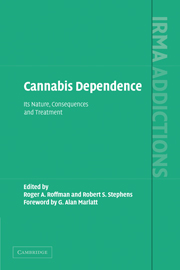Book contents
- Frontmatter
- Contents
- List of Contributors
- Acknowledgments
- Executive Summary
- Foreword
- Part I The Nature of Cannabis Dependence
- Part II Interventions with Cannabis-Dependent Adults
- Part III Interventions with Cannabis-Dependent Adolescents and Young Adults
- 11 The Cannabis Youth Treatment Study: The Treatment Models and Preliminary Findings
- 12 The Teen Cannabis Check-Up: Exploring Strategies for Reaching Young Cannabis Users
- 13 Engaging Young Probation-Referred Marijuana-Abusing Individuals in Treatment
- Part IV Policy
- Part V Conclusion
- Index
12 - The Teen Cannabis Check-Up: Exploring Strategies for Reaching Young Cannabis Users
from Part III - Interventions with Cannabis-Dependent Adolescents and Young Adults
Published online by Cambridge University Press: 29 October 2009
- Frontmatter
- Contents
- List of Contributors
- Acknowledgments
- Executive Summary
- Foreword
- Part I The Nature of Cannabis Dependence
- Part II Interventions with Cannabis-Dependent Adults
- Part III Interventions with Cannabis-Dependent Adolescents and Young Adults
- 11 The Cannabis Youth Treatment Study: The Treatment Models and Preliminary Findings
- 12 The Teen Cannabis Check-Up: Exploring Strategies for Reaching Young Cannabis Users
- 13 Engaging Young Probation-Referred Marijuana-Abusing Individuals in Treatment
- Part IV Policy
- Part V Conclusion
- Index
Summary
This chapter describes a motivational enhancement therapy (MET) intervention tailored to reach young people who use cannabis, motivate them to voluntarily participate in a confidential assessment and evaluation of the impact of cannabis on their lives, and offer support to those who wish to quit or reduce use. After a review of the need for brief interventions and the rationale for using a MET approach with adolescents, we provide an overview of the structure, components, and delivery of the “check-up” approach. This chapter concludes with a description of the application of this approach in two studies recently completed in the USA and Australia.
Epidemiology of Adolescent
Cannabis is so readily available and widely used that experimentation with the drug could be regarded as a normative experience among many young people. A general trend toward increased cannabis use for much of the 1990s was particularly marked among teenagers, possibly due to its ready availability and declining perceptions of risk (e.g., Johnston et al., 2003; Makkai & McAllister, 1997). Despite an apparent slight decrease in use, it remains the most commonly used illicit drug among young people in the USA (Substance Abuse and Mental Health Administration, Office of Applied Studies (SAMHSA), 2003), Australia (Australian Institute of Health and Welfare (AIHW), 2002), New Zealand (Wilkins et al., 2002) and the European Union (European Monitoring Centre for Drugs and Drug Addiction (EMCDDA), 2003; Ramsay & Partridge, 1999).
Keywords
- Type
- Chapter
- Information
- Cannabis DependenceIts Nature, Consequences and Treatment, pp. 275 - 296Publisher: Cambridge University PressPrint publication year: 2006
- 7
- Cited by



